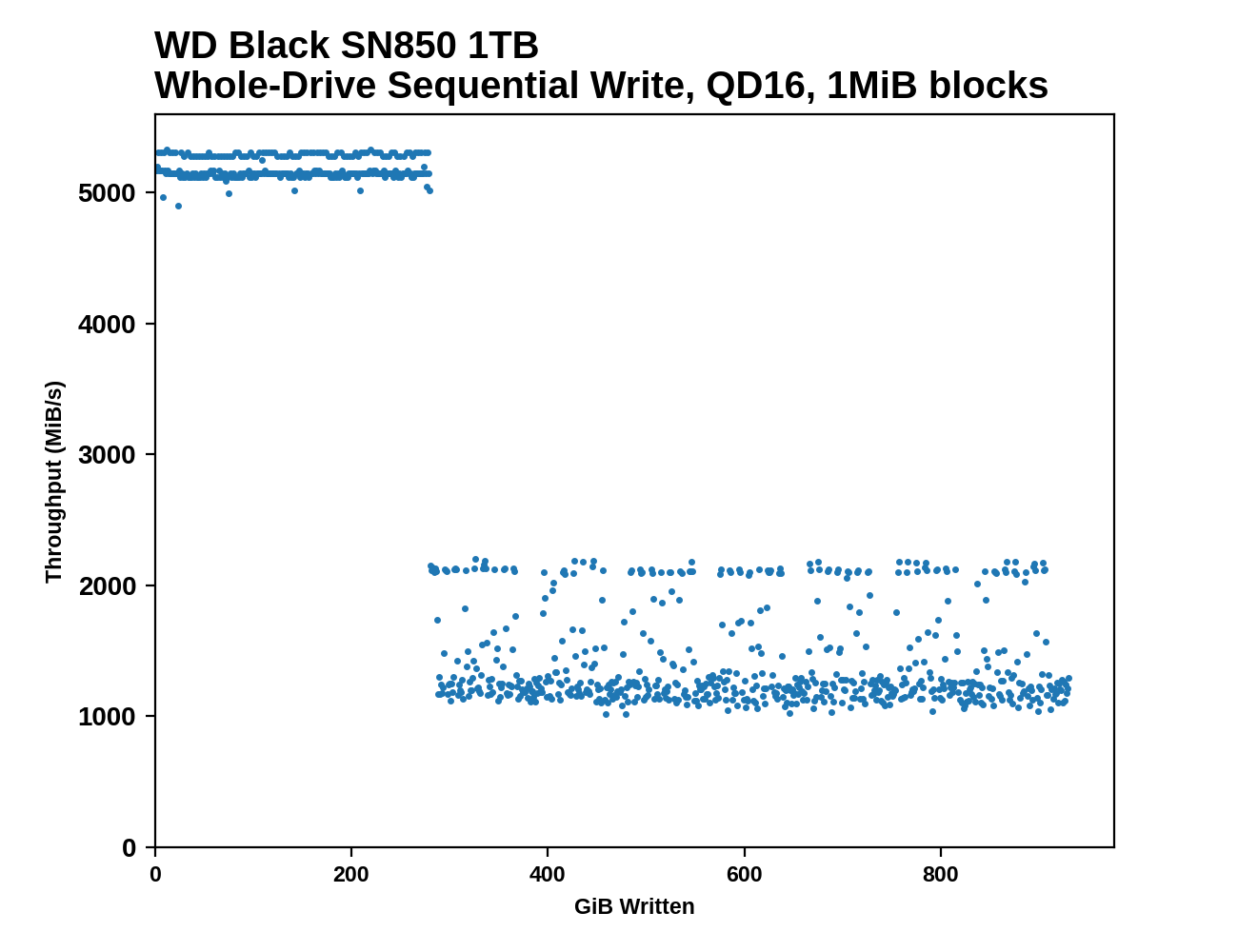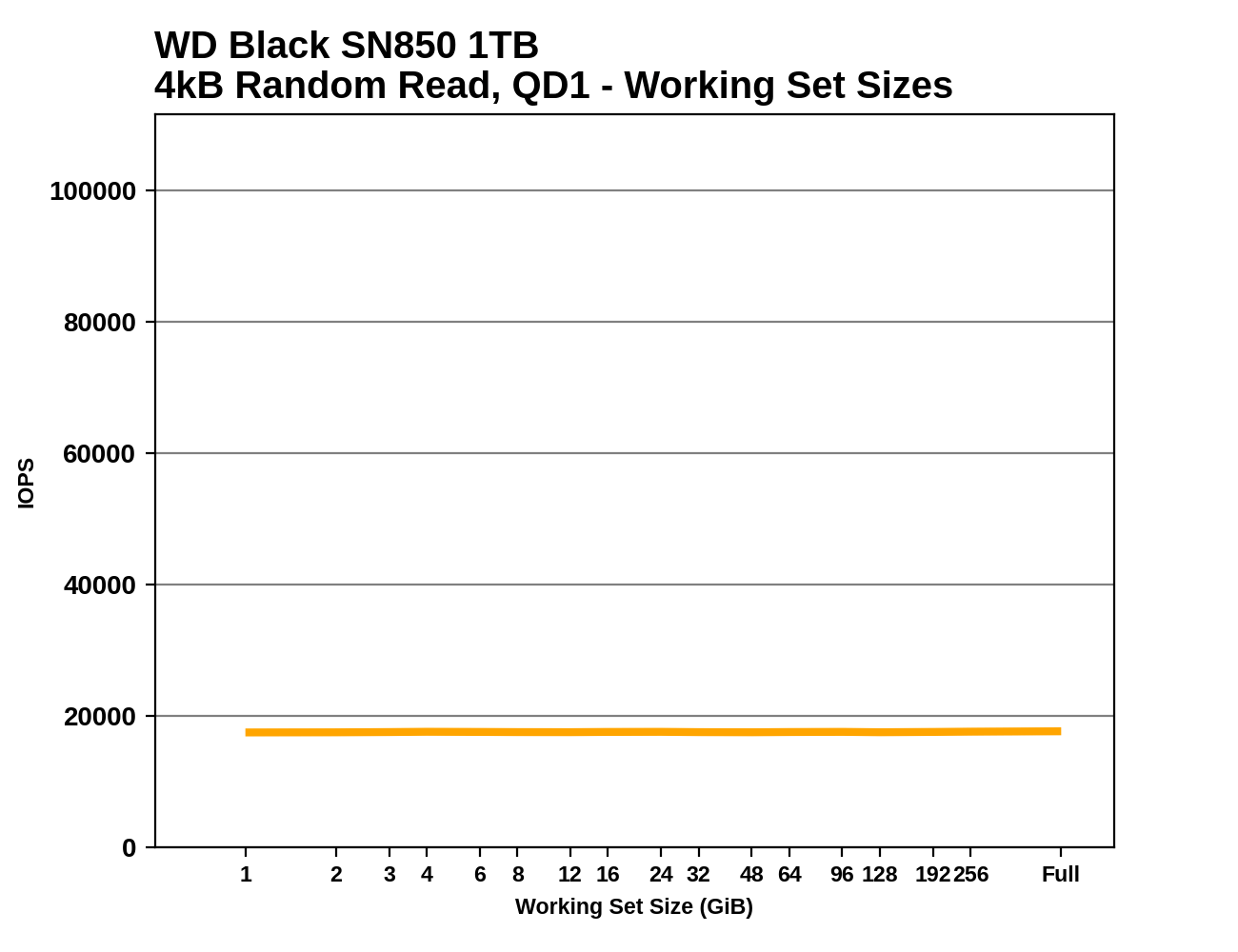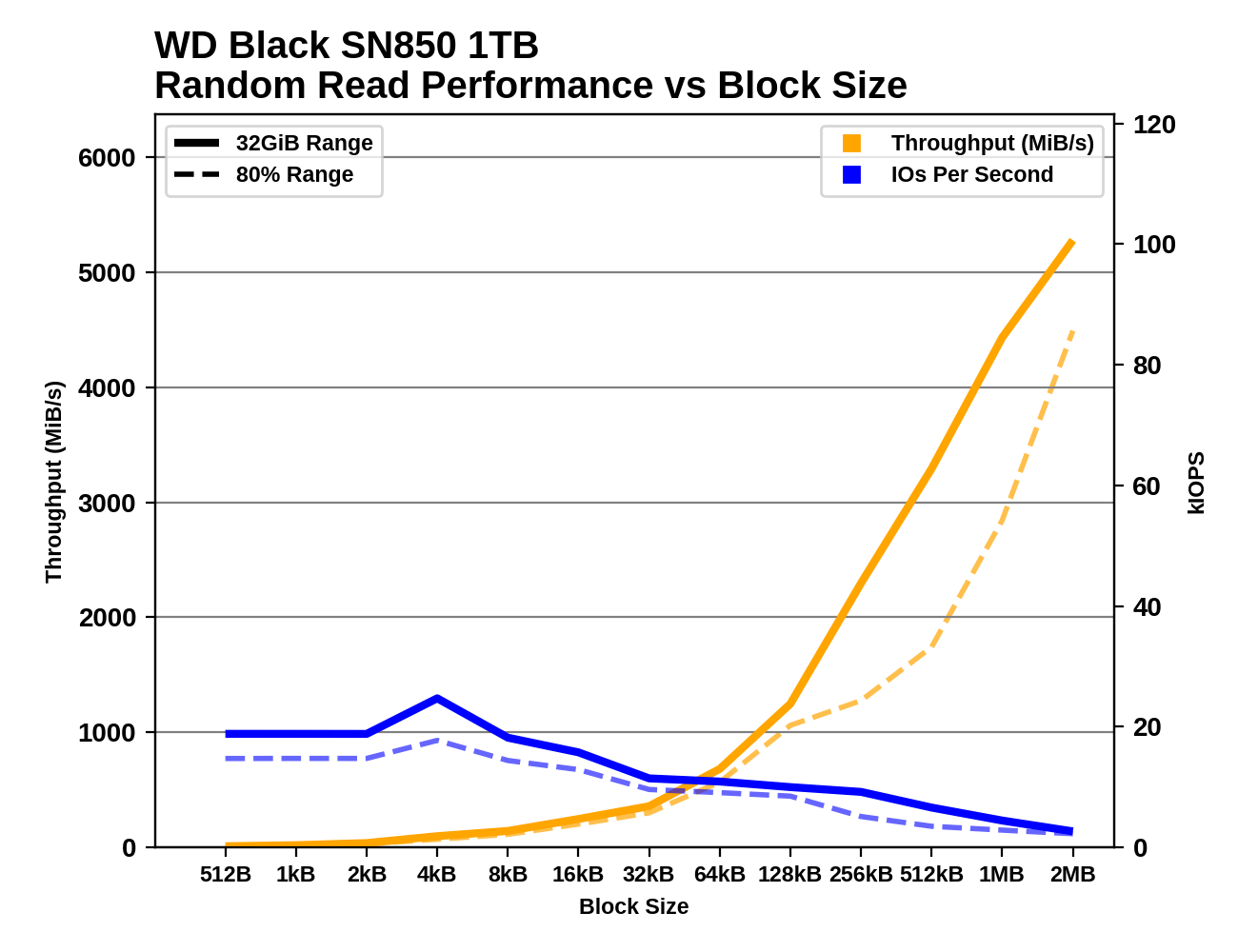The Western Digital WD Black SN850 Review: A Very Fast PCIe 4.0 SSD
by Billy Tallis on March 18, 2021 12:50 PM ESTAdvanced Synthetic Tests
Our benchmark suite includes a variety of tests that are less about replicating any real-world IO patterns, and more about exposing the inner workings of a drive with narrowly-focused tests. Many of these tests will show exaggerated differences between drives, and for the most part that should not be taken as a sign that one drive will be drastically faster for real-world usage. These tests are about satisfying curiosity, and are not good measures of overall drive performance. For more details, please see the overview of our 2021 Consumer SSD Benchmark Suite.
Whole-Drive Fill
 |
|||||||||
| Pass 1 | |||||||||
| Pass 2 | |||||||||
On the first pass starting from an empty drive, the WD Black SN850's SLC cache handles sequential writes at a bit over 5GB/s and the cache lasts for about 281GB before running out. That's a very large SLC cache size for a TLC drive, which is probably why performance is so variable after the cache is full. For the second pass of sequential writes, the cache size has been reduced to about 20GB, but the drive shows a second burst of 20GB of SLC-speed writes later in the test.
 |
|||||||||
| Average Throughput for last 16 GB | Overall Average Throughput | ||||||||
The aggressive SLC caching behavior on the SN850 comes at the cost of slower and less-consistent post-cache write performance, but Western Digital's earlier WD Black SSDs already behaved quite well here. The SN850 manages to keep write speed from ever dropping below 1GB/s, and the overall average across the entire drive fill is basically the same as the SN730, the OEM relative to the SN750 but with the same newer flash as the SN850.
On the second sequential write pass when the SN850's variable-size SLC cache is already at its smallest, post-cache performance is extremely consistent and faster than any other TLC SSD we have tested, but still 15% slower than the MLC-based Samsung 970 PRO.
Working Set Size
 |
|||||||||
Most high-end drives have boring and steady results on this test since they don't skimp on DRAM. The QD1 random read latency for the SN850 is better than any other TLC drive we've tested, and only 4% slower than the MLC-based Samsung 970 PRO.
Performance vs Block Size
 |
|||||||||
| Random Read | |||||||||
| Random Write | |||||||||
| Sequential Read | |||||||||
| Sequential Write | |||||||||
The WD Black SN850 is strongly optimized for 4kB IOs, with lower IOPS and throughput for sub-4kB block sizes on all four workloads. None of the other drives show such broad preferences for 4kB block sizes, but some of Western Digital's drives and a few others show this behavior on at least some of the workloads. This tuning pays off in some places, such as the SN850's leading random write performance for small block sizes (which is followed by the SLC cache running out while testing larger block random writes). There are some other weaknesses including poor performance for small-block sequential reads, but more importantly it has great performance for sequential reads with larger block sizes.










83 Comments
View All Comments
Pinn - Thursday, March 18, 2021 - link
Would love to see thermals.JoeDuarte - Thursday, March 18, 2021 - link
Why are the write latencies so much lower than the read latencies? (For all the drives.) Is this normal for SSDs? I hadn't noticed this pattern before, or read anything about it. My assumption is that reading should be faster than writing.To really move the needle on latency we'll need to move away from PCIe to something like OpenCAPI, which is a much faster interface. Optane can't really stretch out to its full potential if it's going to be hitched to PCIe, even 4.0. With the end of Moore's Law, we really need to optimize the I/O as much as possible, and get rid of interfaces and buses that require many thousands of CPU cycles per transaction.
By the way, why is there no energy usage data for the Optane drive in the results? It seems to be missing for all benchmarks. That drive is in all the performance results except energy usage.
Billy Tallis - Thursday, March 18, 2021 - link
Reading a single page from NAND flash is a lot faster than programming a page. But writes can be cached and several smaller writes can be saved up to be issued in a batch that better uses the parallelism inside the SSD. So the amortized cost of writes can be much lower. Of course, this poses some risk to data in the event of power loss, but that's a generally-accepted tradeoff for consumer systems.The power data for the Optane 905P was left off because its idle power is higher than the peak load power of almost all of the other drives. There aren't a lot of interesting comparisons to be made there. The Optane drive is always the most power-hungry, by far. It would be even without the RGB LEDs. It only has a chance of being competitive on power efficiency for low-QD random reads.
Kamen Rider Blade - Friday, March 19, 2021 - link
Optane is so perfect as a home DeskTop OS drive where the low QD and latency really can be taken advantage of along with it's Random IO and Latency advantages.The vast majority of home users are 90/10 Read/Write.
Spunjji - Friday, March 19, 2021 - link
Only, for that usage, the price/capacity trade-off makes it poor value for money - and the advantages it does confer are barely noticeable in use.FunBunny2 - Friday, March 19, 2021 - link
"Optane is so perfect as a home DeskTop OS drive where the low QD and latency really can be taken advantage of"I would argue the opposite: Optane, et al, make the most sense for industrial strength RDBMS, used in App Mode.
Oxford Guy - Sunday, March 21, 2021 - link
'Of course, this poses some risk to data in the event of power loss, but that's a generally-accepted tradeoff for consumer systems.'Didn't some consumer SSDs have a capacitor to prevent data loss? Has that feature been lost due to the smaller form factor (versus SATA), or is it mainly due to cost-cutting?
Billy Tallis - Sunday, March 21, 2021 - link
There may have been a few "consumer" SSDs back in the very early days that had full power loss protection, but that has been an enterprise-only feature for as long as SSDs have been even remotely mainstream for consumers. (Exceptions: Intel 750 and Optane SSDs, which are re-branded enterprise drives and do have power loss protection.)There have been some consumer SSDs with partial power loss protection, designed to prevent data already on the drive from being corrupted by later writes that get interrupted by a power loss (but making no guarantees about completing any in-progress writes). This doesn't require extra capacitors for writes to SLC or any other single-pass writing (which includes a lot of TLC, if not all of it these days). And since there are also other good reasons not to leave a page in a partially-programmed state for long, I suspect most consumer SSDs have moved away from ever needing the kind of capacitor banks we saw on eg. early Crucial MX series drives.
Oxford Guy - Monday, March 22, 2021 - link
I can imagine that consumers who spends thousands on things like GPUs would be hard-pressed to pay for a capacitor.Good thing the flash drive companies are so watchful of our crucial pennies.
Mikewind Dale - Friday, March 26, 2021 - link
Does having a laptop battery or desktop UPS effectively take the place of power-loss capacitors on an SSD? I would think it does, but I'd like to be sure.